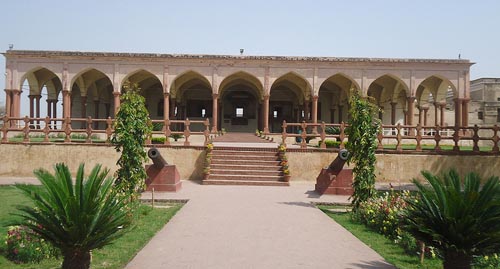Diwan-E-Aam

Information on Diwan-E-Aam (Jaipur, Rajasthan) - History & Architecture
'Diwan-E-Aam' which is also termed as 'Hall of Public Audience' is a fascinating historical monument of Jaipur. It is a key attraction of 'Mubarak Mahal' yard. Traditionally, the king of Jaipur used 'Diwan-E-Aam' as a place of attending various issues of interests. This monument includes durbars, banquet halls and prisons which were also used by the royal women for viewing various proceedings. Presently, this monument has become an art gallery which demonstrate Rajasthani, Mughal and Persian paintings along with antique writings, embroidered carpets and Kashmiri scarves.
Diwan-E-Aam Architecture
The ceiling of 'Diwan-E-Aam' is luxuriously ornamented with red and gold colours. It displays fascinating painted ceiling and rare & antique handwritten genuine script of various popular Hindu figures. 'Diwan-E-Aam' also demonstrate Golden throne which was regarded as the place where king used to sit throughout public proceedings. At the entrance of the hall, there is two big statues of elephants, which are made by single marble rock. Traditionally, king was mounted on elephants or palanquin deliverers through his visit outside the fort. The pillars of the palace possess carved out portraits, developed by numerous artistes of Rajasthan and variety of valuable stones are also entrenched on them. 'Diwan-E-Aam' is featured with wonderful alabaster work, astonishing floral glass display and charming marble designs. Furthermore, the compartments, rooms and gallerias of 'Diwan-E-Aam' are used by king, princes and other royal family members.
Diwan-E-Aam History
'Diwan-E-Aam' was built in 18th century by King Sawai Pratap Singh. It was the place where king used to hear various complaints and accordingly decided actions. Throughout the proceedings, the king used to sit in the middle of the compartment. His protuberant courtiers and colonels sat on the northern side of the compartment and the general people sat on the western side of the compartment. From the southern part of the fort, the royal women used to observe the entire proceedings. It was believed that king Shahjahan was very affectionate regarding marble and thus, variety of marbles can be observed in 'Diwan-E-Aam' palace. This monument has witnessed various glorious moments of Rajput administration.
'Diwan-E-Aam' has been running as a museum for long period of time. It exhibits carriages & howdahs for back ride in elephant and camel, paintings of royal family and rugs from royal home. There are several marbles in the beautiful gallery and one of the famous among all is chandeliers adorn. It is regarded as the biggest marble in India. Nowadays, 'Diwan-E-Aam' has turned into picture gallery with variety of Indian and Persian arts. 'Diwan-E-Aam' is also popular for its beautifully ornamented fancy ceilings.
Diwan-E-Aam Tourism Importance
Due to its historical importance, 'Diwan-E-Aam' is regarded as great place for tourism. It is a subtle palace which can be observed while visiting Amber Fort. It is an inherent portion of socio cultural setting and therefore provide a perceptive glance into the traditional life of people in Jaipur. Due to its historical importance and the splendid architectural phenomenon, tourists often drop to soak in the architectural splendour, which is simply outstanding and splendid. With its appetising architecture, and prospects to explore nearby areas, 'Diwan-E-Aam' is perfectly composed to provide a genuine and exclusive experience to the travellers. There are various ideal scenes in 'Diwan-E-Aam' with prominent objects and paintings. Thus, planning a trip in 'Diwan-E-Aam' and its exciting features can deliver a memorable vacation to the tourists. In summary, a visit to 'Diwan-E-Aam' can deliver greater insight regarding several Indian cultures along with the traditions of Jaipur. So while in Jaipur, come and behold the architectural beauty of Diwan-E-Aam.
- Andaman Nicobar Monuments
- Andhra Pradesh Monuments
- Assam Monuments
- Bihar Monuments
- Chhattisgarh Monuments
- New Delhi Monuments
- Goa Monuments
- Gujarat Monuments
- Haryana Monuments
- Himachal Pradesh Monuments
- Jammu and Kashmir Monuments
- Karnataka Monuments
- Kerala Monuments
- Madhya Pradesh Monuments
- Maharashtra Monuments
- Odisha Monuments
- Punjab Monuments
- Rajasthan Monuments
- Tamil Nadu Monuments
- Telangana Monuments
- Uttar Pradesh Monuments
- West Bengal Monuments